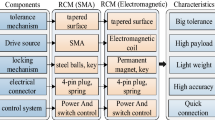Abstract
The demand for more versatile assembly and handling systems to facilitate customized production is gaining in importance, especially with regard to the constantly-increasing cost pressure, to expansion of the range of product versions and the shortening of innovation cycles. As a cost-effective approach for frequently changing assembly tasks, a novel manipulation concept has been developed by combining given robot technologies. This new handling system has a modular and adaptable layout, which consists of several mobile arms to manipulate the object in six-dimensional Cartesian space. After grasping, when the arms are attached to the object, the mechanical architecture is similar to parallel manipulators or cooperating robots. As the mounting and gripping points of the arms can easily be changed, the manipulator can be reconfigured so as to match the user’s preferences and needs. In addition to the kinematic adaption the regarding task, the hardware and new functions can be reconfigured as well. Contact elements, measurement and assembly devices as well as testing modules can easily be in integrated in the concept. A modular automatic control concept combined with a self-optimizing planning tool helps the user to find the optimal configuration and realize it in an economic way.












Similar content being viewed by others
References
Nyhuis P (2008) Wandlungsfähige Produktionssysteme. Heute die Industrie von morgen gestalten. PZH Produktionstechnisches Zentrum, Garbsen
Möller N (2008) Bestimmung der Wirtschaftlichkeit wandlungsfähiger Produktionssysteme. Forschungsbericht IWB, Band 212
Müller R, Corves B, Esser M, Hüsing M, Janßen M, Riedel M (2010) Modular handling platform for easy reconfiguration. In: 3rd CIRP conference on assembly technologies and systems. CATS 2010: Hrsg: Lien, T.; Engineering, D.; Trondheim, N. Conference on assembly technologies and systems 3. CIRP & Tapir Academic Press, Trondheim, pp 109–113
Licha A (2003) Flexible Montageautomatisierung zur Komplettmontage flächenhafter Produktstrukturen durch kooperierende Industrieroboter. Meisenbach, Bamberg
Zou J (2010) Indoor global positioning measurement system application for the aircraft flexible joint assembly. In: Proceedings of the SAE 2010 aerospace manufacturing and automated fastening conference & exhibition, September 2010, Wichita, KS, USA
Premium AEROTEC GmbH: http://www.premium-aerotec.com/Binaries/Binary5687/A350-Grafik_work_packages_DE.jpg. Accessed Aug 2010
Helgosson P, Ossbahr G, Tommlinson D (2010) Modular and configurable steel structure for assembly fixtures. In: Proceedings of the SAE 2010 aerospace manufacturing and automated fastening conference & exhibition, September 2010, Wichita, KS, USA
Millar A, Kihlman H (2009) Reconfigurable flexible tooling for aerospace wing assembly. In: Proceedings of the SAE 2009 aerotech congress & exhibition, November 2009, Seattle, USA
Thomas U, Wahl F (2001) A system for automatic planning, evaluation and execution of assembly sequences for industrial robots. In: Proceedings of the 2001 IEEE/RSJ international conference on intelligent robots and systems. Maui, Hawaii, USA, 1458–1464 October 2001
DeVlieg R, Feikert E (2008) One-up assembly with robots. In: Proceedings of the aerospace manufacturing and automated fastening conference & exhibition, September 2008, North Charleston, SC, USA
Feldmann K, Ziegler C, Michl M (2007) Bewegungssteuerung für kooperierende industrieroboter in der montageautomatisierung. In: wt werkstattstechnik online, Vol. 97, 2007, No. 9, p 713
Bicchi A, Prattichizzo J (2000) Manipulability of cooperating robots with unactuated joints and closed-chain mechanisms. In: IEEE transactions on robotics and automation 16(4): 336–345 August 2000
Riedel M, Nefzi M, Hüsing M, Corves B (2008) An adjustable gripper as a reconfigurable robot with a parallel structure, second international workshop on fundamental issues and future research directions for parallel mechanisms and manipulators
Nefzi M, Riedel M, Corves B (2006) Development and design of a multi-fingered gripper for dexterous manipulation mechatronic systems
Riedel M, Nefzi M, Corves B (2010) Grasp planning for a reconfigurable parallel robot with an underactuated arm structure. In: Proceedings of the 1st international workshop on underactuated grasping
Müller R, Esser M, Janßen C, Vette M (2010) System identification of assembly systems. In: Proceedings in manufacturing systems
Engmann K (2008) Technologie des Flugzeuges. Vogel, Würzburg
KUKA Robotics GmbH (2010) Omnimove. www.kuka-omnimove.com. Accessed Aug 2010
Acknowledgments
As parts of this work are within the scope of the excellence cluster “Integrative Production Technology for high-wage Countries (EXC 128)”, the authors thank the German Research Foundation for its support. This project is part of the sub-category “ICD D-3.2: Flexible Assembly Systems for Selfoptimising Automation” and is realized at RWTH Aachen Technical University in Germany.
Author information
Authors and Affiliations
Corresponding author
Rights and permissions
About this article
Cite this article
Müller, R., Esser, M., Janßen, M. et al. Reconfigurable handling system. Prod. Eng. Res. Devel. 5, 453–461 (2011). https://doi.org/10.1007/s11740-011-0321-2
Received:
Accepted:
Published:
Issue Date:
DOI: https://doi.org/10.1007/s11740-011-0321-2




